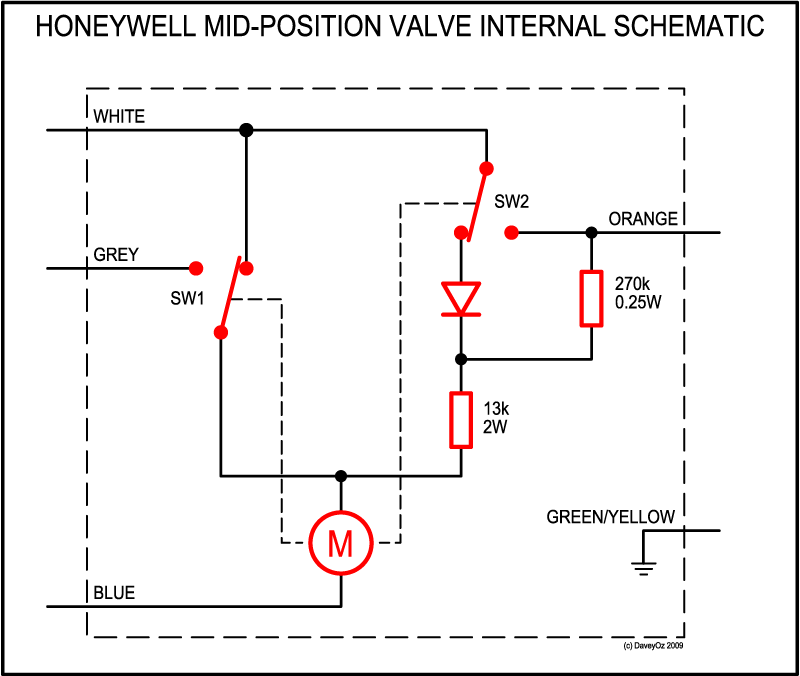Three port mid position valve
The Honeywell V4073A three port, mid position, spring return valve, is a masterpiece of clever engineering. It manages to move to one of three positions using only a cheap non-reversible AC motor, a spring, a couple of micro-switches, a resistor and a diode, and act as a relay for the boiler into the bargain! However, it has obviously required quite a bit of lateral thinking to conjure up, and its operation is thus not easy to understand. Here's how it works.
How the Mid-Position Three Port Valve works
The spring pulls the valve to open the flow through port B (traditionally connected to the hot water cylinder's heating coil), while the motor winds it towards opening port A (feeding the radiator circuit). If the motor is left continuously powered, it will stall in with port A open, but if it is fed with DC (produced with the resistor and the diode), then it will stall in any position. Two micro-switches, operating just either side of the 'A+B' point, are used to define this position.
This is the circuit diagram of the innards of the valve:
The switches SW1 and SW2 are shown in the valve rest position (port B open). As the valve moves over towards the A position, SW1 changes over just before the A+B point, and SW2 just after. The white and grey wires are the control inputs, the orange is the output to the boiler for port A open, and blue is neutral.
In the central heating and hot water "both off" state, the system wiring results in grey being live. If the valve happens to be in the A+B or A port open position, SW1 will have been operated, the motor will be fed with AC, and the valve will wind to open port A and stay there (although the orange boiler output will not be live). This is a fly in the ointment for this valve configuration: the motor can be left consuming power and wearing out its hot windings unnecessarily (the spec says the valve consumes 6W). This will not happen in the summer though, when heating is never selected: SW1 will be at rest, and the valve will sit un-energised with port B open. Note there are changes that can be made to the system wiring to mitigate this feature.
The 270K resistor supplies a small AC current to de-magnetise the motor from the effects of the rectified DC that is used to hold it in the mid-position. Without this, there is some risk that the return spring will not be able to overcome the residual magnetic stiction to return it to the end position.
In the "water only" state, neither grey nor white are energised. The spring will therefore pull the valve back to open port B, where it will sit.
In the "water and heating" state, white is energised. If the valve has port B open, the motor will wind it until A+B, whereupon SW1 changes over, DC is applied to the motor via SW2, and it will stall. If it overshoots, or if it port A was open, SW2 will be operated as well, removing all power from the motor, and allowing the spring to pull the valve back to A+B. It is fun to watch this happening: as the spring pulls the valve back from A open to A+B, the motor acquires quite a momentum and overshoots. It then winds forward a little, and stops in the correct position.
In the "heating only" state, both white and grey are energised (hence the need for a changeover tank stat, and a "hot water not required" output from the programmer). Regardless of the position of either switch, AC will be supplied to the motor, and it will wind to open port A. In addition, SW2 will connect white to orange, switching on the boiler. (The boiler is switched externally to the valve in the other situations.)
As has already been mentioned, a common failure mode is the motor burning out: hence the provision of replaceable heads. In this case, the valve will sit in port B open position and the motor will be cold. The valve can also stiffen up, if water gets in between the two O-rings that seal the actuating shaft. This will manifest itself as the valve sitting in a random position, or in position B but with a hot motor. Applying silicone grease to the operating shaft can cure this: the heating will need to be drained, the valve head and cover removed, and a cir-clip taken off the shaft. The actual valve consists of a freely-rotating rubber ball which is swung on an arm between the two ports.
For more on central heating valves fo all sorts, and full schematics of how they are included in complete systems, please see the Central Heating Controls and Zoning article.
See Also
In this Wiki
External Links
- Discussion of zoning on uk.d-i-y
